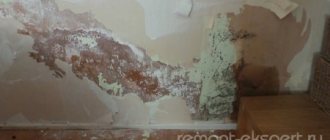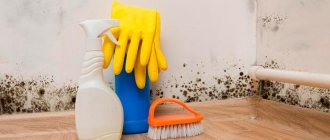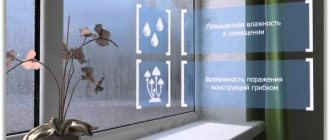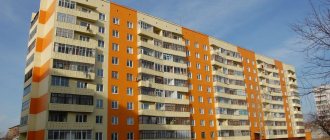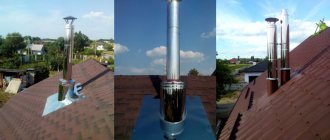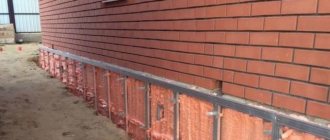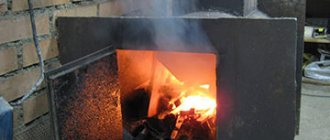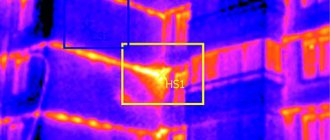Home / Questions and Answers / Corners in a panel house freeze, what should I do? / Cracks in a panel house on the street side, what should I do? / Why do plastic windows cry and how to deal with it in a panel house? / We insulated the balcony, condensation has appeared and the corners are getting wet / The corners in the panel house are freezing, what should I do? / Repair and waterproofing of the roof of the top floor balcony. What is the price? / After external insulation, the walls continue to be damp: what to do? / How to insulate an apartment in a panel house and reduce heat loss in the house? / Is it worth installing a canopy over the facade insulation? / How to seal the seams between floor slabs? / How to fix a balcony leak? Waterproofing a balcony on the top floor / Waterproofing a bay window and what to do if a bay window P-44, P3M is leaking? / Waterproofing a balcony ceiling, eliminating leaks / How much does an industrial climber earn in Moscow? / How to seal seams with sealant in a wooden house? / Hydrophobization of façade walls made of concrete and brick, what is it?
Freezing of a wall in a panel house: reasons
The main reason for this problem is the design of the panel house itself. And it must be said that frozen walls in such buildings are a pressing, widespread problem. Such buildings are built from panels consisting of three layers. The outer and inner ones are made of concrete, and between the layers of concrete there is insulation. This can be polystyrene foam, mineral wool or other insulating material.
Such panels are connected by welding, and a special sealing cord is inserted into the resulting joints between the plates. The joints are sealed with mastic. The result is a monolithic structure, without cold bridges. But this is ideal. But in fact, the installation of the panels is carried out with violations, so the gaps are defective. Moisture gets into these defects, penetrating into the panel and into the insulation.
The main reason is freezing of corners in a house and apartment.
Freezing of corners in the house is a problem faced by many owners of both apartments and private country houses.
What are the reasons? The main reason is errors and shortcomings in the work of builders, violation of technology. Another reason follows from this: the corner, in its essence, is a bridge of cold. In this case, if during the construction of the house the builders saved on masonry mortar or insulation, or poorly sealed the cracks and voids, freezing will make itself felt already in the first frosty days. A cold bridge is a point of sharp transition from heat inside a room to cold outside. Condensation may form at the junction. The consequence of condensation is mold, freezing of corners in the house.
What to do if corners and walls freeze? There are two options - insulation from the outside and from the inside.
- Insulation from the inside. The good news is that you will be protected from the cold. Disadvantage - the wall will be deprived of heat from the room that warms it up. The result is a shift in the dew point and complete freezing of the walls. The consequence of complete freezing is the loss of the walls’ functions, increased moisture levels and the growth of mold.
- Insulating the outside is the right step, which will provide reliable protection against freezing. Thermal insulation of the walls from the outside will seal the structure and prevent mold and condensation from forming.
Why is moisture in insulation harmful?
Water is a good conductor of heat, so a wet insulating material can no longer perform its functions, and the wall becomes colder. As a result, the dew point moves closer to the inner surface of the wall. This displacement leads to the fact that moisture accumulates even more inside the walls and does not become colder. In many cases, the wall is cooled to 0 degrees not from the outside of the panel, but inside, in the insulating layer, or closer to the inside. Accordingly, the water inside the panel freezes in winter - we get freezing of the walls.
After several years of such freezing followed by thawing, the insulation simply collapses and loses its properties.
How to avoid freezing corners in the house
Freezing of any material leads to a significant decrease in its strength. Condensation forms on internal surfaces. To prevent heat loss, an ultra-thin heat insulator has been created. A good example of this kind is AKTERM Facade. These products are used for interior and exterior work. Just one layer is enough to prevent the concrete from decomposing.
Such a new product as AKTERM Anti-Condensate is claimed as a remedy for condensation. Its testing has confirmed that it is excellent when you need to isolate various objects:
The wall freezes, sealing the joints does not help. What is the reason?
Quite often, apartment owners in prefabricated buildings encounter freezing of the walls. Contacting the HOA or the management company does not bring results. More precisely, the management company or homeowners association claims that the root of the problem is poorly sealed seams, they are being repaired, the joints are sealed properly... But the wall continues to freeze. The reason for this phenomenon is simple: while the joints were not sealed, water leaked into the panels, and it did not go away. And if there is moisture inside the panel, freezing will naturally occur. What to do in such cases? Naturally, the problem must be solved individually, but a certain general algorithm of actions exists.
How to determine the source of wall freezing
In old panel houses, as a rule, there is not just one source; most likely, the culprit for the walls freezing in a panel house is several factors at once.
After reading the article about why the walls in the house sweat, you can learn more about why the walls in the houses become wet and how to deal with it.
Poor ventilation is one of the main sources of wall freezing in panel houses
The very first thing you need to do is check the functionality of the ventilation ducts in your house or apartment. If the ventilation “does not work,” then any other corrections will not give a full result.
Lack of heat in the room contributes to freezing of the walls
The first sign of insufficiently hot batteries in winter is damp walls. If this process is started, the moisture will gradually turn into mold. Where does the moisture on the walls come from?
In physics there is such a thing as the “dew point”. In simple terms, it is the point in the wall where water vapor turns into water droplets. So, the colder it is in the house, the closer this point will be to the room, thereby forming moisture on the inside of the wall.
Many people are probably thinking now - where does the water vapor come from in the wall?
Water vapor exists almost everywhere there is air access. And this is especially true for living spaces, since we constantly release them when we prepare food, wash ourselves, even when we just breathe.
The ideal solution in this case would be to insulate the walls outside the house. It's not always easy, but it's the only right decision. Thermal insulation of walls from the inside will probably get rid of visible problems, but in this case, the wall itself behind the insulation will be even wetter, and there will be even more mold on this wall.
Leaky seams between panels or in window openings
The reasons for poor sealing can be either the careless attitude of the builders when building the house, or the old age of the house itself.
How to determine where it's blowing from?
First of all, check all openings, balconies, windows, doors. You can check it with your hand or a lighter. But for a complete check, you will have to remove the old wallpaper from the corners of the room, although if the wall is already frozen, then in any case you will not save the old wallpaper.
After you find “where it’s blowing from,” you need to try to correct it as best as possible.
You can try filling small cracks with silicone sealant, for example, but more serious ones require a more complex approach. Only external insulation, if not of all walls, then at least of problem areas (corners and panel joints) can solve this problem once and for all.
Many people believe that polyurethane foam is a panacea for all ills. Yes, I agree, polyurethane foam works wonders inside a dry room, but it should not be used in conditions of high humidity.
I strongly do not recommend using polyurethane foam to foam street joints. The foam will absorb moisture from the street and transfer it into the room. The corner will remain as raw as it was.
The seams of panel houses are designed for slight deformations, so simply puttingtying the walls won’t do much either. It is necessary to use a material that will be resistant to deformation.
Advice for those who have frozen walls in their home
- Housing and communal services, housing office and various house managements, most likely, will not carry out repairs at their own expense, even if you come to them and write a statement. In order to try to force the management company to make repairs, it is necessary, at a minimum, that the initiative comes from several apartments in a panel building, or better yet, from the majority.
- If you decide to insulate the walls of a panel house from the outside, you will first need to obtain permission from the management company, housing office, etc.
- The walls of a panel house are insulated from the outside, usually with expanded polystyrene (foam plastic). This is certainly not an ideal option, but quite acceptable.
- Before making repairs in an apartment or house with freezing walls, you must first determine why they freeze. Then you need to fix everything and clean the places where moisture or mold has formed, and only then make repairs. Otherwise, you risk throwing money down the drain after making quality repairs.
What to do if it is not possible to conduct a thermal imaging examination?
Then the wall is examined independently; signs of freezing are mold, mildew, and condensation. By touch you can identify colder areas - this indicates that there are metal embedded parts in these places. And very often they are located where the project does not provide for this. The logic of the builders is very interesting in this regard.
Colder sections of the wall are also found where there are voids, or where the insulation is not yet heavily waterlogged. Such places can be found by simply feeling the wall with your hands. It would also be good to determine the places of through blowing - to do this, you need to run a lighter or a burning candle along the walls. It is especially important to pay attention to joints, baseboards, panels, slopes, and window openings. It is best to check by removing the wallpaper from the wall so that the joints are visible. If the apartment is on the top floor, it is worth checking more carefully where the panel adjoins the parapet - very often moisture leaks occur through a poorly made roof.
Leakage of moisture through the roof is an important point. The parapet slab is thinner than the wall slab, and if the roof leaks, 100% of the water goes into the wall. It is better to conduct an inspection of the joint with a representative of the management company; after identifying defects at the junction of the wall and the parapet or the drainage system from the roof, repairs will have to be carried out by the management company. What should be done? Seal the panel joints, repair the roof if necessary, and be sure to dry the wall.
What to do if a corner in a brick house freezes
Of course, even at the construction stage, due attention had to be paid to their thermal insulation. With a written opinion from a specialist, you can contact the management company (HOA) to resolve the issue of correcting the deficiency
In old panel buildings, there are usually several factors that cause walls to freeze. Some new buildings are not immune to this problem. But even if they were insulated, it is not a fact that it was done professionally and with appropriate insulating materials. It is in corner masonry that improper dressing of seams can play the most important role in the occurrence of this problem. The photo shows the search for the cause of freezing. You should not immediately take measures to insulate the room - simple insulation, especially from the inside, will not give practically any effect, but will only shift the dew point, and moisture will condense elsewhere
With a written opinion from a specialist, you can contact the management company (HOA) to resolve the issue of correcting the deficiency. In old panel buildings, there are usually several factors that cause walls to freeze. Some new buildings are not immune to this problem.
But even if they were insulated, it is not a fact that it was done professionally and with appropriate insulating materials. It is in corner masonry that improper dressing of seams can play the most important role in the occurrence of this problem. The photo shows the search for the cause of freezing. You should not immediately take measures to insulate the room - simple insulation, especially from the inside, will not give practically any effect, but will only shift the dew point, and the moisture will condense elsewhere.
And this will significantly worsen the situation. Advice. The problem is identified, as a rule, in the cold season, but it must be solved in the warm season, when it is possible to thoroughly dry the house as a whole and problem areas in particular. The best option:
Wet corners in a panel house
Hello. My family lives on the fifth and last floor in a panel house. At one time, we insulated the corner walls (35 cm) and sections of the wall under the windows. We used 40 mm thick polystyrene foam, plastered it on top and hung wallpaper. Also, new triple-glazed plastic windows were installed. There is no high humidity in the apartment, but condensation constantly forms on the windows, as a result of which the slopes become moldy. Sometimes wet areas and mold spots appear on the ceiling in the area of the corner wall, even if it is not very cold outside, up to -5 degrees. Wetting gets worse when food is being prepared in the kitchen.
The roof is insulated with isover, and roofing felt is laid on top of the insulation. The heating in the apartment is good, the radiators are hot, but the rooms are cool, the temperature does not rise above 21-22 degrees, quite cold. Tell me how to get rid of wet corners and condensation? We live in the city of Uralsk, in the West Kazakhstan region. Basil.
How to deal with wall freezing
The problem of wall freezing is most often complex, and it must be solved using a set of methods, not limited to just one. First of all, you need to find out the exact location and cause of freezing, for which you need to inspect the walls, window and door openings for cracks, masonry defects and interpanel seams (by the way, a very common reason for freezing of walls in panel high-rise buildings).
In some, especially “difficult” cases, specialists armed with a special device – a thermal imager – can come to the rescue. This device helps detect hidden sources of heat leakage. Having discovered such a place, it can be sealed, for example, with polyurethane foam followed by plastering with mortar.
It is best to arrange a “warm facade” system - insulation is laid on the walls, and decorative plaster is applied on top of it or siding or panels are attached. At the same time, it is necessary to resolve issues of repair or reconstruction of the ventilation and heating systems of the premises.
Who is responsible for repairing frozen walls? In private houses, naturally, these are the residents themselves. And in apartment buildings, these are management companies or homeowners associations - they are the ones who are obliged to carry out major repairs of the housing stock. But what to do if the housing office is dragging its feet on repairs? There are some actions you can take yourself:
- If the walls freeze in a room with a loggia or balcony, glaze and insulate it. This will definitely solve some of the problem;
- try to eliminate the cold bridge yourself: groove the desired place to a depth of about a third of the wall thickness, place insulation or polyurethane foam in the recess, and then plaster it. This is especially effective in places under window sills, near door and window frames;
- you can insulate a “capricious” wall from the inside, but not with heat-insulating, but, on the contrary, with heat-conducting materials (expanded clay concrete, fiberboard, etc.). They will “pull back” the dew point inside the wall, thus preventing it from getting wet. But such insulation must be done on a wall that has been previously cleaned of fungus and dried.
Many owners of their own houses, both wooden and brick, are faced with the problem of corners freezing. Why is this happening? There are two reasons: builder mistakes and physics. Any corner in the house, both vertical and horizontal, is, in its geometry, a bridge of cold.
So, if at the construction stage they did not add mortar during laying, skimped on the insulation, or left voids in the concrete, then the corners will definitely freeze. And now physics. During the cold season, the difference between the temperatures outside and in the house is quite large, and, consequently, condensation appears on the cold bridge, which inevitably leads to freezing and the formation of moisture and mold.
Why do corners freeze?
Reasons for freezing:
- errors in construction calculations;
- violation of the technique of dressing brickwork;
- lack of thickness;
- insufficient thermal insulation of the corner;
- insulation from low-quality material;
- lack of material for insulation;
- problems with sealing seams;
- the presence of through voids in the masonry.
Only because of a violation in the calculation technique or the construction of the building in a brick house, the corners become damp and the wall freezes.
Possible consequences
This factor causes the entire room to become damp and cold. This can subsequently cause serious health problems for residents. In addition to the visual effect, which greatly spoils the appearance of the room, a cold wall due to dampness causes mold, which is very difficult to get rid of. In winter, ice fungus appears. The brick undergoes additional destruction and loses its durability. Living in such a room becomes uncomfortable and dangerous to health.
Getting rid of freezing corners
The ideal way to solve the problem is to insulate the entire facade from the outside and reliably seal the seams. It is quite possible to repair your own country house, but in an apartment building you will have to turn to the management company for help. But don't despair. And in a separate apartment you can get a good result.
First of all, you need to remove the wallpaper. If there are no visible cracks, then the walls are tapped with a hammer - where there are voids, the sound will be dull. Next, remove the plaster over the detected cavities and thoroughly dry the corner. If there is mold, be sure to treat it with special antifungal agents. Sometimes mold damage is so extensive that the use of acid, blowtorch fire, or milling of the surface is necessary. All cracks and voids are filled with polyurethane foam or liquid foam. This will prevent moisture from entering the room even if there are cracks in the external wall. Finally, they clean off the remaining foam and plaster the corner. It is best to carry out work in the warm season in order to completely get rid of dampness and mold indoors.
If very large voids are found, you should not fill them with mineral wool or tow, as these materials contribute to the accumulation of moisture. It is better to use the same polyurethane foam. It is resistant to moisture, not susceptible to rotting and mold, has high adhesive properties, and does not lose quality when frozen.
Insulation of the entire façade from the outside
Today, manufacturers offer a variety of materials that greatly facilitate the repair process and take it to a whole new level. For example, special heat-insulating (“warm”) plasters are light mixtures in which microscopic polystyrene foam granules or lightweight natural fillers are used instead of sand. This plaster is several times lighter than regular plaster, it applies and sets well. Due to the presence of air pores, warm mixtures have high vapor permeability, regulate condensation and provide a healthy indoor microclimate. A 50 mm layer of warm plaster has a thermal insulating effect equivalent to one and a half to two bricks or a two-centimeter layer of polystyrene foam.
Not long ago, new materials appeared on the market, produced by different manufacturers under different brands, but united under the common name “liquid thermal insulation”. It is indispensable for problem areas such as freezing corners. The insulating suspension, reminiscent of paint, consists of hollow microspheres (ceramic, glass, silicone or polyurethane) that effectively reflect thermal radiation. Microspheres are suspended in a binding composition of synthetic rubber or acrylic polymers, antifungal and anti-corrosion additives and coloring pigments. This composition gives liquid thermal insulation the properties of waterproofness, flexibility, lightness and strength. The thermal conductivity of liquid heat insulators is significantly lower than that of conventional insulation. Several layers of such paint can replace 5 - 10 cm of polyurethane foam or mineral wool.
True, all this is only from the words of manufacturers and sellers; many practical tests have proven the ineffectiveness of such paint as insulation. Its main task is to reduce heat loss on hot water pipes and boilers.
Application of liquid insulation
The problem of corner freezing can be prevented even at the stage of building a house or renovating a new building. In accordance with the laws of physics, the temperature of the inner surface of the corner is always lower than the temperature of the walls that form this corner. Experienced designers say that ideally the corners of walls, both external and internal, should be rounded or beveled. Rounding or chamfering only the inner corner (with wall material or heat-insulating plaster) can reduce the temperature difference between the walls and the corner by 25-30%. The same role is played by pilasters on the outer corners of the building. This is not only a well-known architectural technique, but also a method of additional insulation.
You can use interesting design solutions. For example, in the corner of the ceiling, mount a plasterboard box with lighting from ordinary incandescent lamps. Working lamps will heat the air inside the structure, thereby moving the dew point inside the wall.

